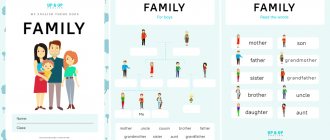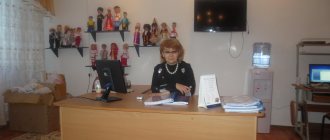Smart cookies: 8 methods of teaching English to children aged 2-3 years
The earlier you start learning a foreign language, the easier and more effective the process will be in the future. Modern parents have long been aware of this fact, and prefer to teach their children English almost from birth. But students start working with teachers when they are 2-3 years old.
But how to teach a child who cannot read, write, and sometimes even speak? To help the teacher - popular methods of teaching English to young learners.
#1 Glen Doman Method
Teachers use Glen Doman's method for children from 6 months to middle school age. The essence of this technique is to show the student special cards with images and say out loud what is depicted on them for a short period of time.
Initially, classes last no more than 10 seconds: one card - 1-2 seconds. Words, like photographs, are imprinted in the child’s brain and the baby quickly remembers a large number of words.
The downside I see is that in this method the child’s role in learning is passive - he just looks at the cards; there is no creativity here. Also, children over 3 years of age are reluctant to accept training using the Doman method if they have not been taught this way before.
#2 Methodology of N. Zaitsev
N. Zaitsev's method is intended for English lessons with children aged five years and older. The essence of the method is to teach a child to read using cubes with syllables. By playing with colorful cubes and testing themselves against the tables included in the set, children learn to formulate English words and sentences correctly.
The peculiarity of Zaitsev’s method is that there are many language exercises that help teach a child to correctly pronounce individual letters and words in any language.
The disadvantages of the method are the laboriousness of creating and storing materials, lack of consistency in training.
#3 Maria Montessori Method
The motto of the technique is: “Help me do it myself.” The essence of the technique is to help him learn independently and freely - for this, the child is placed in a special learning environment with didactic materials.
The teacher has no right to punish, encourage or teach a child; help from the teacher comes only in case of urgent need. The main emphasis is on the development of the child’s intellectual abilities.
In my opinion, the disadvantage of the method is the lack of creative elements in teaching. According to this method, creative games are not only removed from the program of work with children, but are also considered harmful and even inhibiting children's development.
#4 Method of relying on physical actions (Total physical response - TPR)
The essence of this method is that when teaching a foreign language, it is necessary to imitate the process of mastering the native language, which is acquired in parallel with the performance of corresponding physical actions.
The perception of new language structures is facilitated when the teacher and student accompany them with actions. The teacher plays the role of a parent: he says words or simple phrases, for example, “jump” or “look at the notebook,” and the children perform the actions.
The lesson with children goes something like this:
It is not easy to carry out an entire lesson using this method because of the monotony and tediousness, but doing short blocks of 5-7 minutes is a must.
#5 Methodology of V. N. Meshcheryakova
The principle that guides V. Meshcheryakova when developing educational programs is: “Classes should bring pleasure to the child.” Her technique is called “I love English” and consists of several steps:
“I can sing” - for children from 3 to 5 years old. Children learn to perceive English by ear, follow the teacher's commands, play and sing songs in English. Recordings in audio materials were made by native speakers.
“I can speak” - for children from 5 to 7 years old. Children acquire English speaking skills. The teacher speaks only English; other tasks not related to the language are also done in English - this all leads to the fact that the language becomes a part of the children’s lives.
“I can read” - for children from 7 to 8 years old. Children learn to read using familiar language material using the color reading method. At the same time, the goal of training is to develop functional reading skills with immediate understanding of what is read. This technology helps children initially read correctly, both color and black and white text.
“I can write” - for children from 8 to 9 years old. Children learn to write in English and construct sentences grammatically correctly.
“I can analyze” - for children from 9 to 10 years old. The skill of analyzing oral and written language material is developed. Examples of lessons and assignments using this technique can be found in more detail on YouTube.
#6 Project methodology
I use the project method in classes with children aged 4-5 years. The essence of the method is that the teacher chooses a specific topic and then devotes a series of lessons to it. You offer different types of activities in the lesson, with the help of which children learn something interesting and new on the topic of the project. And after that you give more tasks for independent work.
For the final lesson, children bring creative, large-scale works for their age on a given topic.
#7 Learning through video
Video learning involves using only video materials to learn English. These could be films, cartoons in a foreign language, documentary videos, educational video courses.
This technique can be used to teach children of any age, since it is aimed at developing the skills of recognizing foreign speech and its involuntary memorization.
There are various YouTube channels that create video materials for little ones. I use, for example, Nursery Rhymes, ChuchuTV, Mapleleaflearning.
#8 CLIL method
The CLIL method (Content and Language Integrated Learning or subject-language integrated learning) is the study in English (or another foreign language) of all or several subjects - this can be the world around us, drawing, geography, mathematics, literature and even physical education. Most often, a new technique is a combined use of various elements of already known techniques. But which one is more effective and which one should you choose to teach your child? Practice and common sense will help answer these questions.
Try it and you will succeed!
comments powered by HyperComments
Position of specialists
There is no clear answer to the question at what age is it best to start learning a foreign language. It all depends on the individual abilities and desires of the child. However, from an early age, you can include in your child’s daily routine an initial acquaintance with English: learning counting rhymes and the simplest words.
Experts note that if a child has speech problems, then it is impossible to start learning English or any other foreign language. It is important to first deal with speech therapy defects, and only then proceed to new material.
First months of life
Researchers note that acquaintance with foreign speech should occur quite early, before the age of two, only in this case will the child make progress in understanding the norms of English grammar in the future. It is clear that young children are not yet ready to perceive complex information, but they will be happy to listen to a lullaby in English.
You can develop children from 1.5 years old, sometimes weaving phrases in English into their speech, this will help them understand that sounds and words may sound slightly different than in their native Russian. Songs in English are also useful at this age, and experts advise that the child not play foreign pop music, but rather funny children's songs sung by young native speakers.
It is important for parents to understand their main goal - to help their child get acquainted with the English language, interest him, motivate him to further study, and not force him to learn complex rules “under pressure.”
First step
It is very important to conduct the first lesson with your child so that he does not lose interest in subsequent learning. Therefore, it is necessary to use visual material, pictures, music, games. A series of first lessons can be combined with the theme of travel. For example, we are taking an exciting trip to England.
- At the first stop we meet Teddy Bear, the favorite of a large number of British children, with whom we listen to short rhymes.
- Second stop (second day) – meeting with Cinderella, listening to songs.
- The third day is an introduction to the names of English animals, here cards with their images are used.
The learning process will thus turn into an exciting pastime, much more interesting than ordinary games.
Principles of training
Teaching a child English is not easy, since for preschoolers it is important to be able to move actively, rather than sit and learn boring words. Therefore, when practicing at home, you should actively use game forms, visual material, cartoons and musical accompaniment - all this will help the child not to lose interest in training. Lessons should be held regularly; only in this case can one count on success, but not tire the child. You can remember English vocabulary along the way. For example, if during a walk a mother and child meet a cat, the mother may ask: “Who is it? How will it be in English? This will help memorization.
The main task of parents is to instill in their child a sustainable interest in learning the language, the desire to study independently, learn new words and construct phrases. Motivation is very important, so activities should be structured in such a way that children themselves ask for them. The task is not easy, but the result is worth it.
Pictures and toys must be present in classes; parents can come up with a fascinating story and end the lesson, maintaining intrigue, so that the child looks forward to the next day.
It is equally important that the parent who has taken on the responsibility of conducting the lesson must have perfect pronunciation, otherwise the child will get used to articulating incorrectly and will have to relearn it in the future.
Stages
Several stages of training can be distinguished.
- Introduction to transcription and oral speech. To do this, kids simply listen to funny, simple rhymes and songs.
- Studying words. The child gradually learns how familiar words will sound in English.
- Introducing letters and sounds.
- Studying the simplest rules for reading syllables and words.
- Reading text.
Do not deceive yourself - the work is very difficult, so parents should be patient, and if there are gaps in their own knowledge, eliminate them.
Important Rules
Having decided to study at home and introduce the baby to the rules of English speech, parents should adhere to the key rules.
- There should be no criticism, but praise is welcome. Moms and dads should understand that if they do their best to demonstrate their dissatisfaction with the baby’s successes, scold him, get nervous, and break into screams, they can forever kill in the child not only the desire to learn English, but also self-confidence. And praise for success, even if insignificant, will help the preschooler feel more relaxed. You can gradually praise your child even with simple, understandable English phrases; this will help both create motivation and remember them.
- Correct pronunciation is extremely important. Even if parents are fluent in spoken foreign languages, when communicating with their child they must pronounce every sound clearly.
- Various games. The child will become bored if each lesson is carried out according to the same scenario: a rabbit came to visit us, he really wants to get acquainted with English words. The kid will quickly sense the falseness and stop being interested in the rabbit and the lessons themselves. Therefore, creativity, ideas, creativity are required from parents. Lessons can be conducted with the active use of finger games, during drawing or handicrafts, on the street.
- Regular repetition. This is the only way a child can quickly remember vocabulary. Therefore, you need to use every free minute to repeat. For example, during a conversation, a mother can unobtrusively say that she forgot how to say “bear” in English, motivating the baby to remember and prompt.
Only in this way will the child be happy to remember words and actively demonstrate his knowledge.





